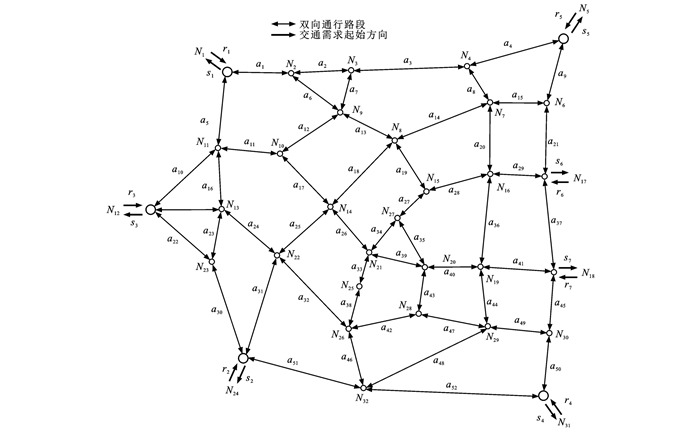-
摘要: 考虑路径阻抗的动态变化, 定义了网络初始荷载; 以事故持续时间为变量, 采用前景理论确定了网络负载重分配的方式; 根据交通流密度熵构建了耗散结构模型, 并与负载分配过程相结合确定了各路段的交通流密度熵变化率; 构建了基于聚类分析的交通事故影响范围分区模型, 通过仿真试验探讨了不同初始荷载和事故持续时间对分区的影响。仿真结果表明: 在交通量基数为800 pcu·h-1时, 事故持续时间从20 min增加到30 min, 直接影响区有向路段由3个增加到6个, 间接影响区有向路段由5个增加到18个, 说明受事故影响路段的熵处于快速上升阶段, 路网的级联失效不明显; 随着交通量基数增加到1 000 pcu·h-1, 事故持续时间从20 min增加到30 min, 直接影响区有向路段由8个增加到19个, 间接影响区有向路段由16个增加到21个, 说明交通量对路网的影响主要集中在直接影响区。可见, 不同交通情况下, 各有向路段受到事故路段的影响程度明显不同, 随着事故持续时间与初始流量的加剧, 路网中有向路段的受影响程度均增大, 因此, 采用交通事故影响范围分区能够精细地描述道路运行状态的动态变化过程。Abstract: The initial load of network was identified based on the dynamic effect of path impedance. The duration of accident was considered as parameter, and the network load re-distribution was introduced based on the prospect theory. The dissipative structure model was established by the entropy of traffic flow density, and the change rate of traffic flow density entropy of each road was determined by combined with the load distribution process. The partition model of traffic accident influence area was established based on cluster analysis. The influence of partition was analyzed by simulation experiment under different initial loads and accident durations. Simulation result shows that when the traffic base is 800 pcu·h-1and the accident duration changes from 20 min to 30 min, the number of directed road sections in direct impact area increases from 3 to 6, and the number of directed road sections in indirect impact area increases from 5 to 18, indicating that the entropy of road section affected by accident is on an upward trend and the cascading failure of road network is not obvious. When the traffic base rises to 1 000 pcu·h-1 and the accident duration changes from 20 min to 30 min, the number of directed road sections in direct impact area increases from 8 to 19, and the number of directed road sections in indirect impact area increases from 16 to 21, indicating that the effect is concentrated on the direct impact area. Therefore, the influence degree of each directed road section affected by accident is obviously different under different traffic situations. With the increases of accident duration and initial traffic flow, the influence degree of accident on directed road sections increases. Therefore, the partition of traffic accident influence area can precisely describe the dynamic evolution process of road traffic performance.
-
表 1 直接影响区有向路段数量
Table 1. Numbers of directed road sections for direct impact area
T/min K/(pcu·h-1) 800 1 000 20 3 8 30 6 19 表 2 间接影响区有向路段数量
Table 2. Numbers of directed road sections for indirect impact area
T/min K/(pcu·h-1) 800 1 000 20 5 16 30 18 21 表 3 各分区内有向路段
Table 3. Directed road sections of each partition
分区编号 有向路段编号 3 a23+、a24-、a25+、a25-、a26+、a27-、a28+、a28-、a29+、a30+、a31+、a31-、a32+、a32-、a33+、a38+、a45+、a46+、a51- 2 a5-、a10+、a11+、a11-、a12+、a13+、a17+、a17-、a18-、a19+、a23-、a24+、a26-、a27+、a34+、a39+、a41-、a42+、a47+、a48-、a49+ 1 其他 -
[1] AMIRGHOLY M, GAO H O. Modeling the dynamics of congestion in large urban networks using the macroscopic fundamental diagram: user equilibrium, system optimum, and pricing strategies[J]. Transportation Research Part B: Methodological, 2017, 104: 215-237. doi: 10.1016/j.trb.2017.07.006 [2] KNOOP V L, VAN LINT H, HOOGENDOORN S P. Traffic dynamics: its impact on the macroscopic fundamental diagram[J]. Physica A: Statistical Mechanics and its Applications, 2015, 438: 236-250. doi: 10.1016/j.physa.2015.06.016 [3] KEYVAN-EKBATANI M, PAPAGEORGIOU M, PAPAMICHAIL I. Urban congestion gating control based on reduced operational network fundamental diagrams[J]. Transportation Research Part C: Emerging Technologies, 2013, 33: 74-87. doi: 10.1016/j.trc.2013.04.010 [4] YILDIRIMOGLU M, GEROLIMINIS N. Approximating dynamic equilibrium conditions with macroscopic fundamental diagrams[J]. Transportation Research Part B: Methodological, 2014, 70: 186-200. doi: 10.1016/j.trb.2014.09.002 [5] MAHMASSANI H S, SABERI M, ZOCKAIE A. Urban network gridlock: theory, characteristics, and dynamics[J]. Transportation Research Part C: Emerging Technologies, 2013, 36: 480-497. doi: 10.1016/j.trc.2013.07.002 [6] KERNER B S. Criticism of generally accepted fundamentals and methodologies of traffic and transportation theory: a brief review[J]. Physica A: Statistical Mechanics and its Applications, 2013, 392(21): 5261-5282. doi: 10.1016/j.physa.2013.06.004 [7] WANG Yu-qi, CAO Jian-nong, LI Wen-gen, et al. Exploring traffic congestion correlation from multiple data sources[J]. Pervasive and Mobile Computing, 2017, 41: 470-483. doi: 10.1016/j.pmcj.2017.03.015 [8] YANG Su. On feature selection for traffic congestion prediction[J]. Transportation Research Part C: Emerging Technologies, 2013, 26: 160-169. doi: 10.1016/j.trc.2012.08.005 [9] KONG Xiang-jie, XU Zhen-zhen, SHEN Guo-jiang, et al. Urban traffic congestion estimation and prediction based on floating car trajectory data[J]. Future Generation Computer Systems, 2016, 61: 97-107. doi: 10.1016/j.future.2015.11.013 [10] HE Fei-fei, YAN Xue-dong, LIU Yang, et al. A traffic congestion assessment method for urban road networks based on speed performance index[J]. Procedia Engineering, 2016, 137: 425-433. doi: 10.1016/j.proeng.2016.01.277 [11] TIAN Jun-fang, TREIBER M, MA Shou-feng, et al. Microscopic driving theory with oscillatory congested states: model and empirical verification[J]. Transportation Research Part B: Methodological, 2015, 71: 138-157. doi: 10.1016/j.trb.2014.11.003 [12] TIAN Jun-fang, LI Guang-yu, TREIBER M, et al. Cellular automaton model simulating spatiotemporal patterns, phase transitions and concave growth pattern of oscillations in traffic flow[J]. Transportation Research Part B: Methodological, 2016, 93: 560-575. doi: 10.1016/j.trb.2016.08.008 [13] CHUNG Y, RECKER W W. A methodological approach for estimating temporal and spatial extent of delays caused by freeway accidents[J]. IEEE Transactions on Intelligent Transportation Systems, 2012, 13(3): 1454-1461. doi: 10.1109/TITS.2012.2190282 [14] CHUNG Y, RECKER W W. Frailty models for the estimation of spatiotemporally maximum congested impact information on freeway accidents[J]. IEEE Transactions on Intelligent Transportation Systems, 2015, 16(4): 2104-2112. doi: 10.1109/TITS.2015.2394798 [15] WANG Zheng-li, QI Xin, JIANG Hai. Estimating the spatiotemporal impact of traffic incidents: an integer programming approach consistent with the propagation of shockwaves[J]. Transportation Research Part B: Methodological, 2018, 111: 356-369. doi: 10.1016/j.trb.2018.02.014 [16] MARSHALL W E, GARRICK N W. Does street network design affect traffic safety?[J]. Accident Analysis and Prevention, 2011, 43(3): 769-781. [17] ZHANG Yuan-yuan, BIGHAM J, RAGLAND D, et al. Investigating the associations between road network structure and non-motorist accidents[J]. Journal of Transport Geography, 2015, 42: 34-47. doi: 10.1016/j.jtrangeo.2014.10.010 [18] SUN Chen-shuo, PEI Xin, HAO Jun-heng, et al. Role of road network features in the evaluation of incident impacts on urban traffic mobility[J]. Transportation Research part B: Methodological, 2018, 117: 101-116. doi: 10.1016/j.trb.2018.08.013 [19] MFINANGA D, FUNGO E. Impact of incidents on traffic congestion in Dares Salaam City[J]. International Journal of Transportation Science and Technology, 2013, 2(2): 95-108. doi: 10.1260/2046-0430.2.2.95 [20] HOJATI A T, FERREIRA L, WASHINGTON S, et al. Modelling the impact of traffic incidents on travel time reliability[J]. Transportation Research Part C: Emerging Technologies, 2016, 65: 49-60. [21] KADDOURA I, NAGEL K. Using real-world traffic incident data in transport modeling[J]. Procedia Computer Science, 2018, 130: 880-885. doi: 10.1016/j.procs.2018.04.084 [22] 刘伟, 陈科全, 刘玉印, 等. 前景理论下道路网络的级联失效演变[J]. 交通运输系统工程与信息, 2018, 18(1): 145-151. https://www.cnki.com.cn/Article/CJFDTOTAL-YSXT201801023.htmLIU Wei, CHEN Ke-quan, LIU Yu-yin, et al. Cascading failure simulation of road network based on prospect theory[J]. Journal of Transportation Systems Engineering and Information Technology, 2018, 18(1): 145-151. (in Chinese). https://www.cnki.com.cn/Article/CJFDTOTAL-YSXT201801023.htm [23] 马壮林, 邵春福, 胡大伟, 等. 高速公路交通事故起数时空分析模型[J]. 交通运输工程学报, 2012, 12(2): 93-99. http://transport.chd.edu.cn/article/id/201202013MA Zhuang-lin, SHAO Chun-fu, HU Da-wei, et al. Temporal-spatial analysis model of traffic accident frequency on expressway[J]. Journal of Traffic and Transportation Engineering, 2012, 12(2): 93-99. (in Chinese). http://transport.chd.edu.cn/article/id/201202013 [24] 金书鑫, 王建军, 徐嫚谷. 区域高速路网交通事故影响区划分及交通诱导[J]. 长安大学学报(自然科学版), 2017, 37(2): 89-98. https://www.cnki.com.cn/Article/CJFDTOTAL-XAGL201702011.htmJIN Shu-xin, WANG Jian-jun, XU Man-gu. Traffic accident affected zone division and traffic guidance under regional highway network[J]. Journal of Chang'an University(Natural Science Edition), 2017, 37(2): 89-98. (in Chinese). https://www.cnki.com.cn/Article/CJFDTOTAL-XAGL201702011.htm [25] 肖恢翚, 陆建, 邱红桐, 等. 城市快速路交通事件影响范围预测模型[J]. 哈尔滨工业大学学报, 2016, 48(9): 54-59. https://www.cnki.com.cn/Article/CJFDTOTAL-HEBX201609010.htmXIAO Hui-hui, LU Jian, QIU Hong-tong, et al. The range forecast model of traffic incidents impact on urban expressway[J]. Journal of Harbin Institute of Technology, 2016, 48(9): 54-59. (in Chinese). https://www.cnki.com.cn/Article/CJFDTOTAL-HEBX201609010.htm [26] 王正武, 陈小兰, 李常乐. 道路交通网络级联失效影响源辨识[J]. 中国公路学报, 2015, 28(10): 98-104. https://www.cnki.com.cn/Article/CJFDTOTAL-ZGGL201510015.htmWANG Zheng-wu, CHEN Xiao-lan, LI Chang-le. Identifying influence sources of cascading failure for road traffic network[J]. China Journal of Highway and Transport, 2015, 28(10): 98-104. https://www.cnki.com.cn/Article/CJFDTOTAL-ZGGL201510015.htm [27] 任小聪, 向红艳, 陈坚. 交通事故信息对路径选择行为的影响建模与分析[J]. 公路交通科技, 2016, 33(7): 103-107, 113. https://www.cnki.com.cn/Article/CJFDTOTAL-GLJK201607016.htmREN Xiao-cong, XIANG Hong-yan, CHEN Jian. Modeling and analysis of influence of traffic accident information on route choice behavior[J]. Journal of Highway and Transportation Research and Development, 2016, 33(7): 103-107, 113. (in Chinese). https://www.cnki.com.cn/Article/CJFDTOTAL-GLJK201607016.htm [28] TVERSKY A, KAHEMAN D. Advances in prospect theory: cumulative representation of uncertainty[J]. Journal of Risk and Uncertainty, 1992, 5: 297-323. [29] 莫祥伦. 城市道路交通流自组织运行机理及控制研究[D]. 长春: 吉林大学, 2014.MO Xiang-lun. Study on operation mechanism and control of self-organization traffic flow in urban road net[D]. Changchun: Jilin University, 2014. (in Chinese). [30] 石小法, 王炜, 杨东援. 信息对出行者出行行为的影响研究[J]. 中国公路学报, 2002, 15(1): 89-92. https://www.cnki.com.cn/Article/CJFDTOTAL-ZGGL200201021.htmSHI Xiao-fa, WANG Wei, YANG Dong-yuan. Bounded-rational travel behavior under traffic incident[J]. China Journal of Highway and Transport, 2002, 15(1): 89-92. (in Chinese). https://www.cnki.com.cn/Article/CJFDTOTAL-ZGGL200201021.htm -





 下载:
下载:







